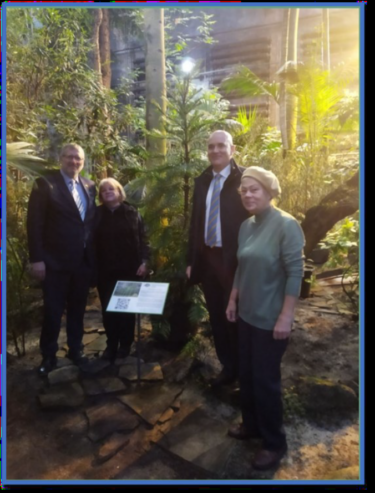Australian Ambassador to Ukraine, HE Bruce Edwards (second from right), inspecting the Wollemi pine in November 2023
What follows is an edited version of an article by Greg Johnson (AGHS ACT) that appeared in the International Society for Plant Pathology
Newsletter 54 (1) January 2024.
In June 2023, the O V Fomin Botanical Garden in Kyiv received a rare plant – a Wollemia pine (Wollemia nobilis) — from Australia to mark the 30th anniversary of the establishment of diplomatic relations between Australia and Ukraine. The tree was delivered to Kyiv by Shaun Hopkins and Jenny Jenkins, British volunteers with the charity UK4UA, which has helped get much needed medicines and supplies to Poland and Ukraine for almost two years. During a visit to Kyiv in November 2023, the Australian Ambassador, HE Bruce Edwards, met the OV Fomin Botanical Garden’s Director, Maria Gaidarzhy, and was able to check on the progress of the tree, speak with the botanical garden workers, see how the collection of greenhouse plants are kept in winter, and find out how volunteers can help the botanical garden. He was pleased to see the tree thriving in the greenhouse complex, forming cones and lateral shoots. “Great trees from small seedlings grow” and the Wollemia in the Botanic Garden is a symbol of strong friendship and partnership.
The tree in Kyiv was propagated from trees sent by the Royal Botanic Gardens in Sydney to Kew Gardens in the UK in 1997.
The OV Fomin Botanical Garden, is named after botanist, Oleksandr Vasylyovytch Fomin (1869-1935) and is one of the oldest botanical gardens in Ukraine, founded in 1839 and planned by architect V Beretti and botanist R E Trautfetter, as part of the then Saint Volodymyr Imperial University of Kyiv, which since 1939 has been known as the Taras Shevchenko National University of Kyiv. The Garden encompasses 22.5 hectares in central Kyiv, with 17 greenhouses and 12 orangeries and collections focused on in woody plants of the temperate and subtropical regions. It holds more than 8,000 species, including c. 4,000 tropical and subtropical plants.
The Garden has a tumultuous history: virtually destroyed in the First World War, after being shelled and then looted by soldiers. In the Second World War, the Nazis cut down many old trees for firewood and looted dozens of palms and orchids. In 1974, city authorities reconstructed the garden and in 1978 the greenhouse complex was built, with a 32m Kilatron, the highest in the world at that time. The complex now houses many tropical plants and palms including a 30m tall Livistona palm, which was planted in 1839 and which flowers regularly.
Other Australian highlights at the gardens are an Illawarra flame tree, Brachychiton acerifolius, a cycad, Livistona australis (about 30 m), and a kauri, Araucaria bidwillii (25 m).
Now the centre of another war, the gardens have again suffered from a combination of things: water shortages from bombed infrastructure and power cuts that meant the greenhouses could not be heated and some plants were lost. In 2022, the Ukraine Botanic Garden Appeal was launched and is ongoing.


